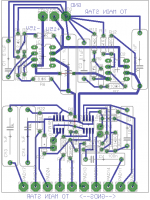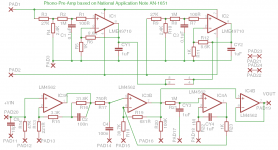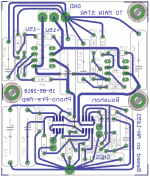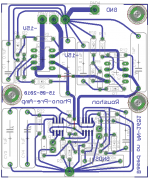Here is a single-sided pcb-design (with two jumpers) for a phono pre-amp circuit based on the National Application Note AN-1651.
I request for suggestions and corrections in the design.
Regards
Roushon
I request for suggestions and corrections in the design.
Regards
Roushon
Attachments
Last edited:
Thanks Joachim. R18 is 38.7R. I corrected it now. I am following the Topology 2 (Active/Passive) in the application note. Half of IC4 is not used, so
I made a unity gain buffer out of it. I know it is not required, but it is not of any harm if added I hope.
Regards
Roushon
I made a unity gain buffer out of it. I know it is not required, but it is not of any harm if added I hope.
Regards
Roushon
Last edited:
Putting a buffer in my sound better when you drive long and demanding cables, so yes, it does not hurt. You could also build a switchable subsonic filter.
Putting a buffer in my sound better when you drive long and demanding cables, so yes, it does not hurt. You could also build a switchable subsonic filter.
That is a very good idea. Thank you very much. I will work on to convert the
unused opamp into a subsonic filter.
Best regards
Roushon.
On the pcb: do not use 90 deg. anles on traces. In the etching process (especially home-made boards) undercutting at the anle could happen). Use only obtuse angles (135 deg. or greater). The star grounding you are employing is not required here. It is used in high power systems where a ground lead could be modulated causing hum and feedback. Not using star grounding can reduce the pcb size. E
On the pcb: do not use 90 deg. anles on traces. In the etching process (especially home-made boards) undercutting at the anle could happen). Use only obtuse angles (135 deg. or greater). The star grounding you are employing is not required here. It is used in high power systems where a ground lead could be modulated causing hum and feedback. Not using star grounding can reduce the pcb size. E
Thanks a lot for your suggestions. I will make the angles smooth. About the
ground connection can I make only one ground connection from the board, meaning, is fusing all the ground end from both upper and lower parts of the
pcb to a single point OK?
Regards
Roushon
Hi,
I am also working on the same app note. But, I am using hard wiring with ultra pure silver wires instead of the PCB's. Also, I am using single opamp's instead of the dual version. What is the supply you are using ?
Best regards,
Bins.
I am also working on the same app note. But, I am using hard wiring with ultra pure silver wires instead of the PCB's. Also, I am using single opamp's instead of the dual version. What is the supply you are using ?
Best regards,
Bins.
Thanks a lot for your suggestions. I will make the angles smooth. About the
ground connection can I make only one ground connection from the board, meaning, is fusing all the ground end from both upper and lower parts of the
pcb to a single point OK?
Regards
Roushon
I will be using +-15v as shown in the application note made using LM317 and LM337. I have surface mount type ICs, so I need a PCB.
Re: Grounding
You can safely connect your PAD11-18 to your main ground or common through a single point to point trace. The traces are to short and the currents to small (and balanced out) to matter. As a personal rule I make the supply traces wider (as you did) and double them for the common.
E
You can safely connect your PAD11-18 to your main ground or common through a single point to point trace. The traces are to short and the currents to small (and balanced out) to matter. As a personal rule I make the supply traces wider (as you did) and double them for the common.
E
Our posts overlapped! I would add a second pad to PAD3(?) GND to take a wire from your new star ground to there and than to the raw DC supply. As you did star grounds all around there is no need for increasing the common trace sizes. Good luck!
E
E
Hi,
Try Bugle power supply. It is more advanced than a basic LM317/LM337 based supply.
Best regards,
Bins.
Try Bugle power supply. It is more advanced than a basic LM317/LM337 based supply.
Best regards,
Bins.
I will be using +-15v as shown in the application note made using LM317 and LM337. I have surface mount type ICs, so I need a PCB.
Hi,
Try Bugle power supply. It is more advanced than a basic LM317/LM337 based supply.
Best regards,
Bins.
Thanks! I did not know that it is a basic PS. I will keep in mind Bugle PS.
Regards
Roushon
Bugle
Hi Binspaul,
Can you kindly post a Bugle PS circuit? I just searched the net and found one such circuit using 7815 and 7915 and zenner diodes. But I think 317 and 337 are more flexible and reliable. May be you can post something better.
Regards
Roushon
Hi Binspaul,
Can you kindly post a Bugle PS circuit? I just searched the net and found one such circuit using 7815 and 7915 and zenner diodes. But I think 317 and 337 are more flexible and reliable. May be you can post something better.
Regards
Roushon
Our posts overlapped! I would add a second pad to PAD3(?) GND to take a wire from your new star ground to there and than to the raw DC supply. As you did star grounds all around there is no need for increasing the common trace sizes. Good luck!
E
Thank you again. I will do that.
Regards
Roushon
The Bugle Phono Pre-Amp Power Supply is at Hagerman Technology LLC.
Hagerman Technology LLC: Bugle Opamp Moving Magnet Budget Phonostage DIY Kit
Hagerman Technology LLC: Bugle Opamp Moving Magnet Budget Phonostage DIY Kit
The Bugle Phono Pre-Amp Power Supply is at Hagerman Technology LLC.
Hagerman Technology LLC: Bugle Opamp Moving Magnet Budget Phonostage DIY Kit
This is exactly the circuit I mentioned. It uses 7815 and 7915. The circuit uses some
bleeder resistors also. I do not see how this is better than 317 and 337.
Regards
Roushon.
- Status
- Not open for further replies.
- Home
- Source & Line
- Analogue Source
- A PCB-design for Phono-pre-amp



